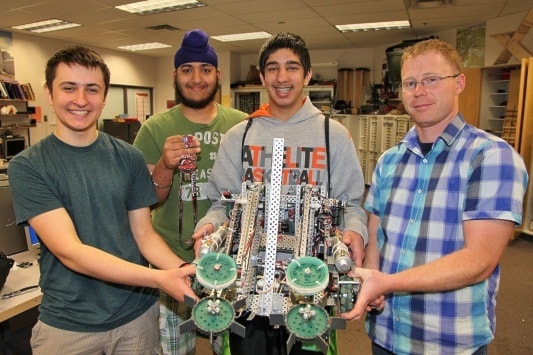Robot enthusiasts from Enver Creek Secondary have pitted their machine against global competition at a world championship event in California.
The robot created by the students in Envertronics, the schools’ robotics club, placed 30th out of 86 teams in their division at the VEX Robotics High School World Championships in Anaheim. Their division rivals included teams from Kazakhstan, Puerto Rico, New Zealand, Hong Kong, Spain, China, Saudi Arabia, Singapore and the US.
Unlike many of the teams they faced, Envertronics is not part of a school program, but an extra-curricular club that meets in lunch breaks and after school once a week.
“They have probably 10 or 11 hours more to work on their robots than we do, but still for what we have we did really well compared to other teams”, says Envertronics member Nick Tsimoshkin.
Other members of the club who made the trip to Anaheim were Pauldeep Nagra, Sari Siyam, Devansh Babla, Baljinder Atwal, Lovdeep Singh, Maximillian Yong and Munraj Grewal. The latter called the experience “awesome.”
The team says they have learned from the competition and seeing how other teams approached this year’s challenge to create a robot that can hang, overcome obstacles and throw balls to score points. They have already started work on the robot they hope with get them to next year’s world championships and tackle the challenge of building block towers.
The club is organized by Travis Burroughs, who teaches engineering, drafting and metalwork at the school.
“This was one of the most challenging games that they have had to play,” he says. “To get everything right – moving quickly and figuring out the pneumatics to throw the balls – was one of the most difficult tasks and one that many teams weren’t capable of figuring out.”
Burroughs said the Enver Creek team tapped the expertise of physics teacher Paul Cheng to help them master the angles and pressures for the pneumatics.
“I’m proud of them, they did well,” he adds. “Hopefully we get there again next year and do better. I think they’re capable of doing better.”
And the students, who often buy their own equipment to supplement that bought with generous support from the school PAC and a couple of other donors, are well on the way to success; a number of former club members are now in engineering programs at BCIT, UBC and SFU.
